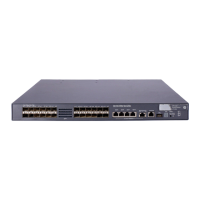7
To do… Use the command… Remarks
4. Display the enabled
debugging functions.
display debugging [ interface
interface-type interface-number ]
[ module-name ] [ | { begin |
exclude | include } regular-
expression ]
Optional.
Available in any view.
NOTE:
To display the detailed debugging information on the terminal, configure the debugging, terminal
debugging and terminal monitor commands. For more information about the terminal debugging
and
terminal monitor commands, see Information center commands
in the
Network Management and
Monitoring Command Reference
.
Configuring ping and tracert example
Network requirements
As shown in Figure 4, Device A failed to Telnet Device C. Determine whether Device A and Device C can
reach each other. If they cannot reach each other, locate the failed nodes in the network.
Figure 4 Ping and tracert network diagram
Configuration procedure
# Use the ping command to display whether Device A and Device C can reach each other.
<DeviceA> ping 1.1.2.2
PING 1.1.2.2: 56 data bytes, press CTRL_C to break
Request time out
Request time out
Request time out
Request time out
Request time out
--- 1.1.2.2 ping statistics ---
5 packet(s) transmitted
0 packet(s) received
100.00% packet loss
# Device A and Device C cannot reach each other. Use the tracert command to determine failed nodes.
<DeviceA> system-view
[DeviceA] ip ttl-expires enable
[DeviceA] ip unreachables enable
[DeviceA] tracert 1.1.2.2
traceroute to 1.1.2.2(1.1.2.2) 30 hops max,40 bytes packet, press CTRL_C to bre
ak
1 1.1.1.2 14 ms 10 ms 20 ms

